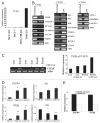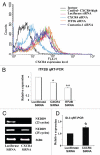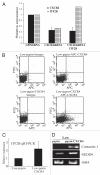ITF2 is a target of CXCR4 in MDA-MB-231 breast cancer cells and is associated with reduced survival in estrogen receptor-negative breast cancer
- PMID: 20603605
- PMCID: PMC3040950
- DOI: 10.4161/cbt.10.6.12586
ITF2 is a target of CXCR4 in MDA-MB-231 breast cancer cells and is associated with reduced survival in estrogen receptor-negative breast cancer
Abstract
CXCR4, a chemokine receptor, plays an important role in breast cancer growth, invasion, and metastasis. The transcriptional targets of CXCR4 signaling are not known. Microarray analysis of CXCR4-enriched and CXCR4-low subpopulations of the MDA-MB-231 breast cancer cell line, which has a constitutively active CXCR4 signaling network, revealed differential expression of ∼ 200 genes in the CXCR4-enriched subpopulation. ITF2, upregulated in CXCR4-enriched cells, was investigated further. Expression array datasets of primary breast tumors revealed higher ITF2 expression in estrogen receptor negative tumors, which correlated with reduced progression free and overall survival and suggested its relevance in breast cancer progression. CXCL12, a CXCR4 ligand, increased ITF2 expression in MDA-MB-231 cells. ITF2 is a basic helix-loop-helix transcription factor that controls the epithelial-to-mesenchymal transition and the function of the ID family (inhibitor-of-differentiation) of transcription factors, such as ID2. ID2 promotes differentiation of breast epithelial cells and its reduced expression in breast cancer is associated with an unfavorable prognosis. Both CXCR4 and ITF2 repressed ID2 expression. In xenograft studies, CXCR4-enriched cells formed large tumors and exhibited significantly elevated lung metastasis. Short interfering RNA against ITF2 reduced invasion of the CXCR4-enriched MDA-MB-231 subpopulation, whereas ITF2 overexpression restored the invasive capacity of MDA-MB-231 cells expressing CXCR4shRNA. Furthermore, overexpression of ITF2 in these cells enhanced tumor growth. We propose that ITF2 is one of the CXCR4 targets, which is involved in CXCR4-dependent tumor growth and invasion of breast cancer cells.
Figures








Comment in
-
CXCR4 signaling identifies a role for IFT2 in ER-negative breast cancers.Cancer Biol Ther. 2010 Sep 15;10(6):615-6. doi: 10.4161/cbt.10.6.12906. Epub 2010 Sep 7. Cancer Biol Ther. 2010. PMID: 20686361 No abstract available.
Similar articles
-
CXCR4 signaling identifies a role for IFT2 in ER-negative breast cancers.Cancer Biol Ther. 2010 Sep 15;10(6):615-6. doi: 10.4161/cbt.10.6.12906. Epub 2010 Sep 7. Cancer Biol Ther. 2010. PMID: 20686361 No abstract available.
-
ITF2 prevents activation of the β-catenin-TCF4 complex in colon cancer cells and levels decrease with tumor progression.Gastroenterology. 2014 Aug;147(2):430-442.e8. doi: 10.1053/j.gastro.2014.04.047. Epub 2014 May 15. Gastroenterology. 2014. PMID: 24846398
-
Effects of SDF-1-CXCR4 signaling on microRNA expression and tumorigenesis in estrogen receptor-alpha (ER-α)-positive breast cancer cells.Exp Cell Res. 2011 Nov 1;317(18):2573-81. doi: 10.1016/j.yexcr.2011.08.016. Epub 2011 Aug 30. Exp Cell Res. 2011. PMID: 21906588 Free PMC article.
-
Genetic manipulation of stromal cell-derived factor-1 attests the pivotal role of the autocrine SDF-1-CXCR4 pathway in the aggressiveness of breast cancer cells.Int J Oncol. 2005 May;26(5):1429-34. Int J Oncol. 2005. PMID: 15809737
-
Epigenetic changes of CXCR4 and its ligand CXCL12 as prognostic factors for sporadic breast cancer.PLoS One. 2011;6(12):e29461. doi: 10.1371/journal.pone.0029461. Epub 2011 Dec 29. PLoS One. 2011. PMID: 22220212 Free PMC article.
Cited by
-
A Boolean approach for novel hypoxia-related gene discovery.PLoS One. 2022 Aug 25;17(8):e0273524. doi: 10.1371/journal.pone.0273524. eCollection 2022. PLoS One. 2022. PMID: 36006949 Free PMC article.
-
Polygonum cuspidatum Extract (Pc-Ex) Containing Emodin Suppresses Lung Cancer-Induced Cachexia by Suppressing TCF4/TWIST1 Complex-Induced PTHrP Expression.Nutrients. 2022 Apr 5;14(7):1508. doi: 10.3390/nu14071508. Nutrients. 2022. PMID: 35406121 Free PMC article.
-
Protein stabilization of ITF2 by NF-κB prevents colitis-associated cancer development.Nat Commun. 2023 Apr 25;14(1):2363. doi: 10.1038/s41467-023-38080-w. Nat Commun. 2023. PMID: 37185280 Free PMC article.
-
Sustained conditional knockdown reveals intracellular bone sialoprotein as essential for breast cancer skeletal metastasis.Oncotarget. 2014 Jul 30;5(14):5510-22. doi: 10.18632/oncotarget.2132. Oncotarget. 2014. PMID: 24980816 Free PMC article.
-
Transcriptional responses of cultured rat sympathetic neurons during BMP-7-induced dendritic growth.PLoS One. 2011;6(7):e21754. doi: 10.1371/journal.pone.0021754. Epub 2011 Jul 13. PLoS One. 2011. PMID: 21765909 Free PMC article.
References
-
- Steeg PS. Tumor metastasis: mechanistic insights and clinical challenges. Nat Med. 2006;12:895–904. - PubMed
-
- Balkwill F. Cancer and the chemokine network. Nat Rev Cancer. 2004;4:540–550. - PubMed
-
- Orimo A, Gupta PB, Sgroi DC, Arenzana-Seisdedos F, Delaunay T, Naeem R, et al. Stromal fibroblasts present in invasive human breast carcinomas promote tumor growth and angiogenesis through elevated SDF-1/CXCL12 secretion. Cell. 2005;121:335–348. - PubMed
-
- Muller A, Homey B, Soto H, Ge N, Catron D, Buchanan ME, et al. Involvement of chemokine receptors in breast cancer metastasis. Nature. 2001;410:50–56. - PubMed
Publication types
MeSH terms
Substances
Associated data
- Actions
LinkOut - more resources
Full Text Sources
Medical
Molecular Biology Databases
Miscellaneous
